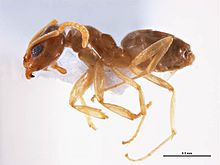
Myrmecology is a branch of entomology focusing on the scientific study of ants. Some early myrmecologists considered ant society as the ideal form of society and sought to find solutions to human problems by studying them. Ants continue to be a model of choice for the study of questions on the evolution of social systems because of their complex and varied forms of eusociality. Their diversity and prominence in ecosystems also has made them important components in the study of biodiversity and conservation. Recently, ant colonies are also studied and modeled for their relevance in machine learning, complex interactive networks, stochasticity of encounter and interaction networks, parallel computing, and other computing fields.
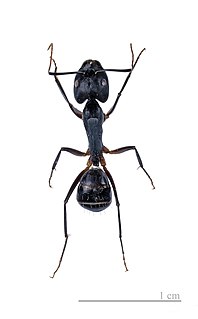
The Formicinae are a subfamily within the Formicidae containing ants of moderate evolutionary development.

Myrmeciinae is a subfamily of the Formicidae, ants once found worldwide but now restricted to Australia and New Caledonia. This subfamily is one of several ant subfamilies which possess gamergates, female worker ants which are able to mate and reproduce, thus sustaining the colony after the loss of the queen. The Myrmeciinae subfamily was formerly composed of only one genus, Myrmecia, but the subfamily was redescribed by Ward & Brady in 2003 to include two tribes and four genera: An additional three genera, one form genus, and 9 species were described in 2006 from the Early Eocene of Denmark, Canada, and Washington.

Dolichoderinae is a subfamily of ants, which includes species such as the Argentine ant, the erratic ant, the odorous house ant, and the cone ant. The subfamily presents a great diversity of species throughout the world, distributed in different biogeographic regions, from the Palearctic, Nearctic, Afrotropical region and Malaysia, to the Middle East, Australian, and Neotropical regions.
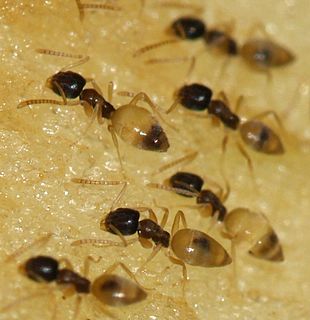
Tapinoma is a genus of ants that belongs to the subfamily Dolichoderinae. The genus currently comprises 74 described species distributed worldwide in tropical and temperate regions. Members of are generalized foragers, nesting in a wide variety of habitats, ranging from grasslands, open fields, woodlands, to inside buildings. The majority of species nest in the ground under objects such as stones or tree logs, other species build nests under bark of logs and stumps, in plant cavities, insect galls or refuse piles.

The banded sugar ant, also known as the sugar ant, is a species of ant native to Australia. A member of the genus Camponotus in the subfamily Formicinae, it was described by German entomologist Wilhelm Ferdinand Erichson in 1842. Its common name refers to the ant's liking for sugar and sweet food, as well as the distinctive orange-brown band that wraps around its gaster.

Iridomyrmex, or the rainbow ant is a genus of ant first described by Austrian entomologist Gustav Mayr in 1862. He placed it in the subfamily Dolichoderinae of the family Formicidae. There are 79 described species and five fossil species. Most of these ants are native to Australia; others are found in several countries and islands in Asia and other areas in Oceania, and they have been introduced to Brazil, New Zealand and the United Arab Emirates. Fossil species are known from China, France and the United States.
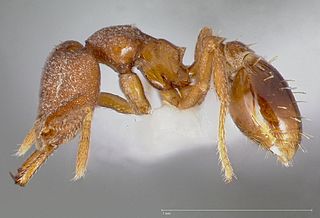
Strumigenys is a genus of ants in the subfamily Myrmicinae.

Stereomyrmex is a genus of myrmicine ants. Two of the described species are known from only a single worker, making this one of the rarest groups of ants in the world.
John S. Clark was a Scottish-born Australian entomologist and myrmecologist known for his study of Australian ants. Born in Glasgow, he developed an interest in entomology at a young age. Clark first arrived in Australia in 1905 and originally worked for the state railways in Queensland. He developed an interest in ants shortly afterwards, collecting his first specimens in North Queensland. He married his first wife, Maggie Forbes in 1908, bearing four children, until her death in 1935. He married his second wife, Phyllis Marjorie Claringbulls in 1939 and had two daughters with her until she committed suicide in 1943. As a result, Clark sent his daughters to an orphanage.

Doleromyrma darwiniana is a species of ant in the genus Doleromyrma. Described by Forel in 1907, the species is endemic to Australia and introduced to New Zealand, and it nests in soil or under stones and logs. The organism grows to a length between 2.0 and 3.0 millimeters. This species of ant maintains small colony sizes and it "prefers protein food." The species is also known by some sources as the "brown house ant" and "Darwin's ant". The species is considered a "minor urban pest" in New South Wales.
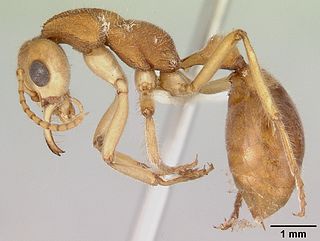
Prionomyrmecini is an ant tribe belonging to the subfamily Myrmeciinae established by William Morton Wheeler in 1915. Two members are a part of this tribe, the extant Nothomyrmecia and the extinct Prionomyrmex. The tribe was once considered a subfamily due to the similarities between Nothomyrmecia and Prionomyrmex, but such reclassification was not widely accepted by the scientific community. These ants can be identified by their long slender bodies, powerful stingers and elongated mandibles. Fossil Prionomyrmecini ants were once found throughout Europe, possibly nesting in trees and preferring jungle habitats. Today, Prionomyrmecini is only found in Australia, preferring old-growth mallee woodland surrounded by Eucalyptus trees. Nothomyrmecia workers feed on nectar and arthropods, using their compound eyes for prey and navigational purposes. Owing to their primitive nature, they do not recruit others to food sources or create pheromone trails. Nothomyrmecia colonies are small, consisting of 50 to 100 individuals.

Cerapachys is a genus of ants in the subfamily Dorylinae. Species are mainly myrmecophagous ants which raid the nests of other ants for prey. The genus is distributed widely throughout the tropical and subtropical regions of the world, with the majority of species known from the Indo-Australian region.

Melophorus is a genus of ants in the subfamily Formicinae and the sole member of the tribe Melophorini. The genus is endemic to Australia, where its species are common in arid and semiarid areas.

Leptomyrmecini is a tribe of Dolichoderinae ants with 16 genera and two extinct genera.
Dolichoderus clusor is a species of ant in the genus Dolichoderus. Described by Forel in 1907, the species mostly live in dry sclerophyll and forages on tree trunks. Populations are known from Western Australia and South Australia. Ants of this species have been observed nesting under masses of dead grass, which were located under a stone.

Leptomyrmex darlingtoni is a species of ant in the genus Leptomyrmex. Described by William Morton Wheeler in 1934, the species is endemic to Australia.

The black-headed sugar ant, also known as the brown sugar ant, is a species of Formicinae ant endemic to Australia. Found throughout most states, the species is a member of the genus Camponotus, a cosmopolitan genus of ants commonly known as carpenter ants. It was formally described and named by British entomologist Frederick Smith in 1858. These ants are characterised by their black head, reddish-brown mesosoma and black gaster, which can change in colour.
